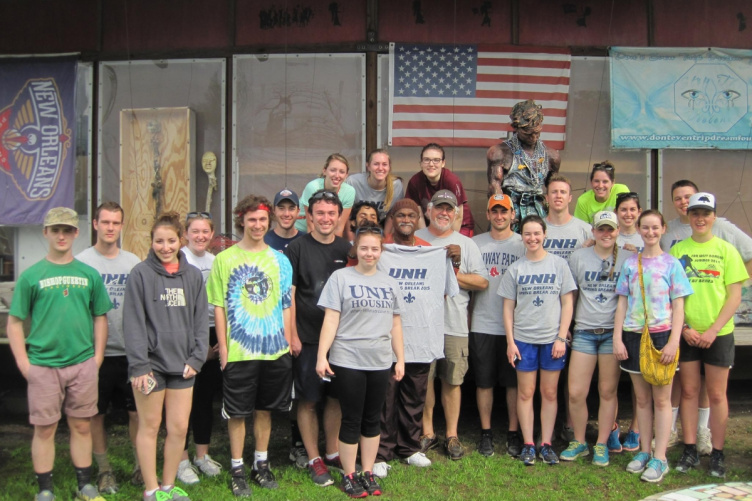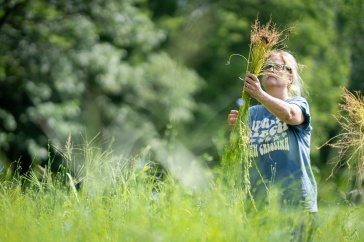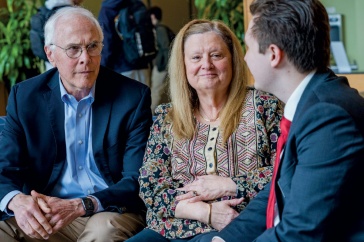
When a group of UNH students finally heard the music on the street corners of New Orleans; when they took a ride with a friendly carriage driver who rode around with his pet snake (and told them tales of how many more he had at home); when they tasted their first Gulf shrimp, their first po'boy, their first muffuletta and when they danced for the first time behind a second line in a street parade — it all clicked.
This was the New Orleans the students had spent weeks learning about — from Creole history to Hurricane Katrina, from beignets and jambalaya to Congo Square and Louis Armstrong — as part of the honors course "New Orleans: Place, Meaning, and Context," taught by professor Bill Ross, who is also head of the Milne Special Collections and Archives at UNH's Dimond Library.
The spring semester course delves deep into one of the most diverse, dynamic and unique cities in America, by allowing students to study its music, history, people, culture, politics and art.
Then, students spend spring break in the city. By day, they work with lowernine.org, a nonprofit organization helping the Lower Ninth Ward recover from Hurricane Katrina and the subsequent levee breaches that wreaked havoc on the area in 2005. They help repair houses in the neighborhood that became Ground Zero not only for Katrina's destruction, but also the subsequent battles over landowners' rights, education, corruption and reform and red tape that kept residents from returning.
"Students in this course gain the recognition that there is a place in this country that is so different. They truly get an immersive experience," Ross says. And in working with lowernine.org, he adds, "I think they can have a concrete connection with what happened."
While UNH students see mostly the vacant lots, houses once stood in this neighborhood that once had the highest rate of home ownership in the city, populated by mostly working class African-Americans.
"It's devastating, trying to explain that each one of those concrete slabs was a home. And those 10 concrete slabs were a block, and that block after block made up a community — and all of it was gone, literally washed away," says Ross, who did his own volunteering with FEMA in the wake of Hurricane Katrina. "The objective of service learning is not just to help other people, but also to learn more about yourself and how you respond to different situations and different experiences.”
His students learned those lessons and more during their week with lowernine.org. “We met the owners of the house we were working on — he even brought us pralines as a way to say thank you!” says Gabrielle Raymond ’18.
Ross has been teaching this course for roughly 10 years. He first visited the Crescent City in the 1970s, and since then has become a scholar on the topic of New Orleans. The first half of the course is what he calls "New Orleans boot camp," about seven or eight weeks to study the history, language, significant people past and present of the city, using sources from literature, pop culture, current events, documentaries and film. This year he included lessons on the neighborhoods of New Orleans as an important feature in the fabric of the city's culture. The second half focuses on literature and major themes such as class and race, Katrina and its aftermath and the image of New Orleans in the American psyche.

"For me personally working in the Lower Ninth Ward for the last three years in a row, you get to know the people, and for me, that's very rewarding," says professor Bill Ross, who worked alongside his students. "It's a very graphic reminder to the students of what was lost during Hurricane Katrina ... they're looking at a neighborhood that's only a third of the way back after 10 years. They got to meet the homeowners and got to know them. They weren't just doing this work in a vaccuum, they are doing it to get people back into their homes." (Photo: Kelly Trainor ’18)
Prior to the trip, students talked about what they were most interested in seeing, after having spent several weeks studying so many different facets of NOLA culture.
Andrew Doppstadt '17 admitted that he was pretty excited to try the food — beignets, po'boys, everything. But beyond that, he was looking forward to seeing in real-time the post-Katrina condition of the city and other parts of New Orleans culture.
"I think this class is really cool because we didn't just focus on the history of the city, we talk about everything. We had one whole class that just focused on voodoo — not many people get to take a class like that," Doppstadt says.
Emily Haley '18 says being able to learn about something and then go see it was what made her want to sign up for the course.

The Mardi Gras Indians on "Super Sunday" (the Sunday closest to St. Joseph's Day) were one of the many highlights of the UNH class trip to New Orleans. (Photo: Kelly Trainor ’18)
"Getting the background information makes it all the more real. We had a better connection than if we had just gone down for a trip, without all the context from the course," she says.
Two main takeaways from the students’ New Orleans experience: slow down and engage. “Now that I think of it, you hardly saw anyone walking around with their phone out. They were just immersed in whatever they were doing at the moment. They live in the present a little bit more,” than we New Englanders do says Olivia Black ’18.
Their work schedules had them painting, moving bricks and performing other tasks for lowernine.org each day until about 4:30 p.m., but then they were able to immerse themselves in the city — listening to music, watching a second line perform, seeing the intricate costumes of the Mardi Gras Indians and even dancing in the streets behind a parade float during the city's massive St. Patrick's Day Parade.
Seeing the Mardi Gras Indians march, says Kelly Trainor '18, was when it all clicked.
"That's when I understood what Bill meant when he was saying 'You have to go there to understand it.' He was right — there are literally no words to describe this experience to someone else," Trainor says.
Black agrees.
"At first I didn't feel like I quite understood the culture — French architecture, trolley cars?" Black admits. "And all the news headlines... Going so far in-depth on a particular place, you realize how many components there are that make up its culture. It's so cool just to immerse yourself in the class and then actually get to go.
"The trip made everything we had learned make even more sense."
About This Series
In the Classroom is an occassional series of articles that offer an inside peek at some of the most interesting courses being taught this semester at UNH.
-
Written By:
Michelle Morrissey ’97 | UNH Magazine | michelle.morrissey@unh.edu



















































